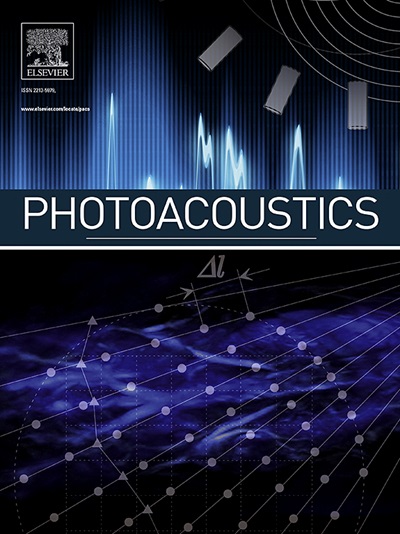Signal-domain speed-of-sound correction for ring-array-based photoacoustic tomography
IF 7.1
1区 医学
Q1 ENGINEERING, BIOMEDICAL
引用次数: 0
Abstract
Photoacoustic imaging combines the advantages of optical and acoustic imaging, making it a promising tool in biomedical imaging. Photoacoustic tomography (PAT) reconstructs images by solving the inverse problem from detected photoacoustic waves to initial pressure map. The heterogeneous speed of sound (SoS) distribution in biological tissue significantly affects image quality, as uncertain SoS variations can cause image distortions. Previously reported dual-speed-of-sound (dual-SoS) imaging methods effectively address these distortions by accounting for the SoS differences between tissues and the coupling medium. However, these methods require recalculating the distribution parameters of the SoS for each frame during dynamic imaging, which is highly time-consuming and poses a significant challenge for achieving real-time dynamic dual-SoS PAT imaging. To address this issue, we propose a signal-domain dual-SoS correction method for PAT image reconstruction. In this method, two distinct SoS regions are differentiated by recognizing the photoacoustic signal features of the imaging target's contours. The signals are then corrected based on the respective SoS values, enabling signal-domain-based dual-SoS dynamic real-time PAT imaging. The proposed method was validated through numerical simulations and in-vivo experiments of human finger. The results show that, compared to the single-SoS reconstruction method, the proposed approach produces higher-quality images, achieving the resolution error by near 12 times and a 30 % increase in contrast. Furthermore, the method enables dual-SoS dynamic real-time PAT reconstruction at 10 fps, which is 187.22 % faster than existing dual-SoS reconstruction methods, highlighting its feasibility for dynamic PAT imaging of heterogeneous tissues.
基于环阵光声层析成像的信号域声速校正
光声成像结合了光学成像和声成像的优点,是生物医学成像中很有前途的工具。光声层析成像(PAT)通过解决从探测到的光声波到初始压力图的逆问题来重建图像。声速在生物组织中的不均匀分布会显著影响图像质量,因为不确定的声速变化会导致图像失真。先前报道的双声速成像方法通过考虑组织和耦合介质之间的声速差异,有效地解决了这些失真。然而,这些方法需要在动态成像过程中重新计算每帧SoS的分布参数,这是非常耗时的,并且对实现实时动态双SoS PAT成像提出了重大挑战。为了解决这个问题,我们提出了一种用于PAT图像重建的信号域双sos校正方法。该方法通过识别成像目标轮廓的光声信号特征来区分两个不同的SoS区域。然后根据各自的SoS值对信号进行校正,从而实现基于信号域的双SoS动态实时PAT成像。通过数值模拟和人体手指实验验证了该方法的有效性。结果表明,与单sos重建方法相比,该方法产生的图像质量更高,分辨率误差提高了近12倍,对比度提高了30 %。此外,该方法以10 fps的速度实现双sos动态实时PAT重建,比现有双sos重建方法快187.22 %,突出了其用于异质组织动态PAT成像的可行性。
本文章由计算机程序翻译,如有差异,请以英文原文为准。
求助全文
约1分钟内获得全文
求助全文
来源期刊

Photoacoustics
Physics and Astronomy-Atomic and Molecular Physics, and Optics
CiteScore
11.40
自引率
16.50%
发文量
96
审稿时长
53 days
期刊介绍:
The open access Photoacoustics journal (PACS) aims to publish original research and review contributions in the field of photoacoustics-optoacoustics-thermoacoustics. This field utilizes acoustical and ultrasonic phenomena excited by electromagnetic radiation for the detection, visualization, and characterization of various materials and biological tissues, including living organisms.
Recent advancements in laser technologies, ultrasound detection approaches, inverse theory, and fast reconstruction algorithms have greatly supported the rapid progress in this field. The unique contrast provided by molecular absorption in photoacoustic-optoacoustic-thermoacoustic methods has allowed for addressing unmet biological and medical needs such as pre-clinical research, clinical imaging of vasculature, tissue and disease physiology, drug efficacy, surgery guidance, and therapy monitoring.
Applications of this field encompass a wide range of medical imaging and sensing applications, including cancer, vascular diseases, brain neurophysiology, ophthalmology, and diabetes. Moreover, photoacoustics-optoacoustics-thermoacoustics is a multidisciplinary field, with contributions from chemistry and nanotechnology, where novel materials such as biodegradable nanoparticles, organic dyes, targeted agents, theranostic probes, and genetically expressed markers are being actively developed.
These advanced materials have significantly improved the signal-to-noise ratio and tissue contrast in photoacoustic methods.
 求助内容:
求助内容: 应助结果提醒方式:
应助结果提醒方式:


